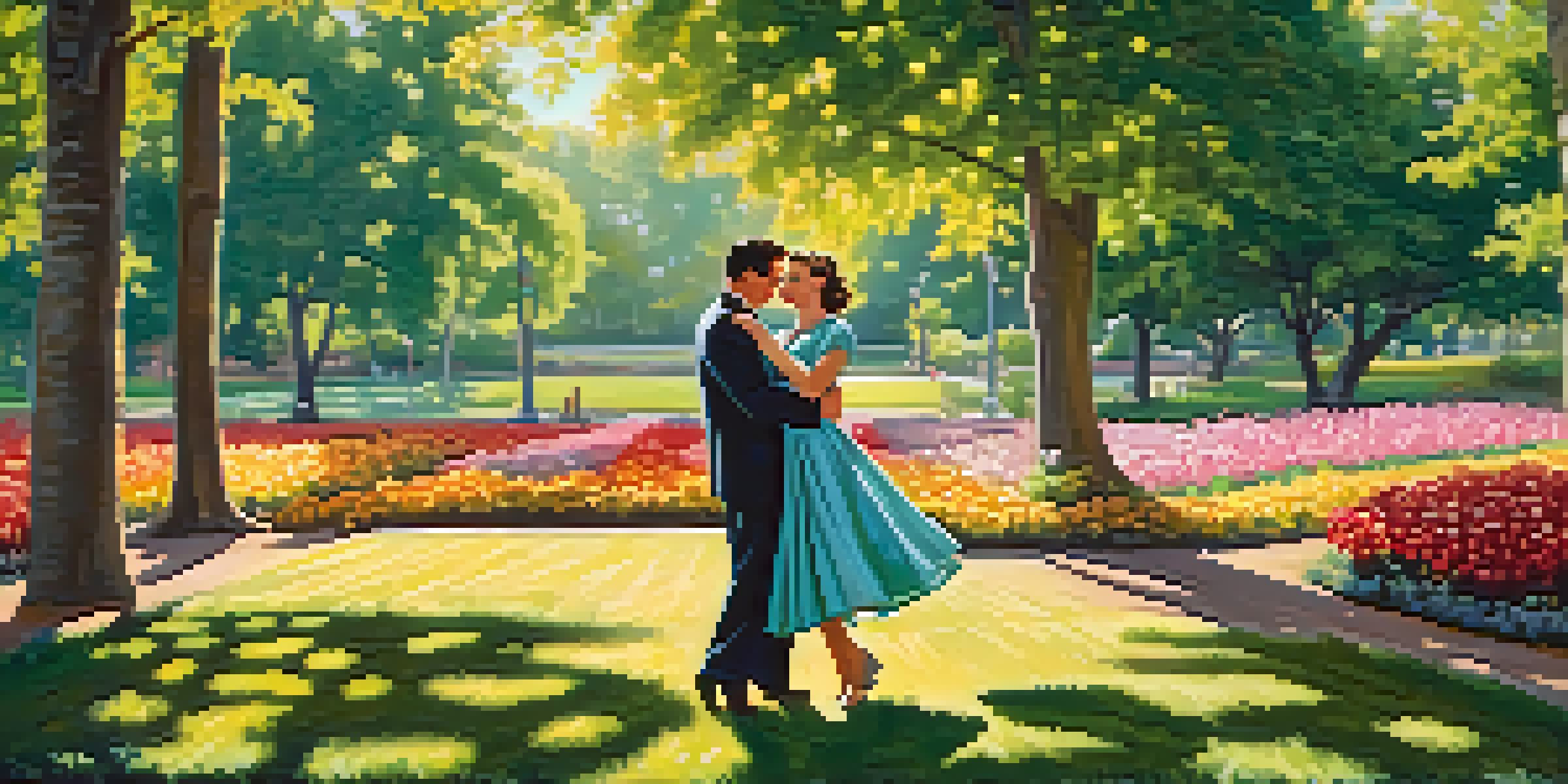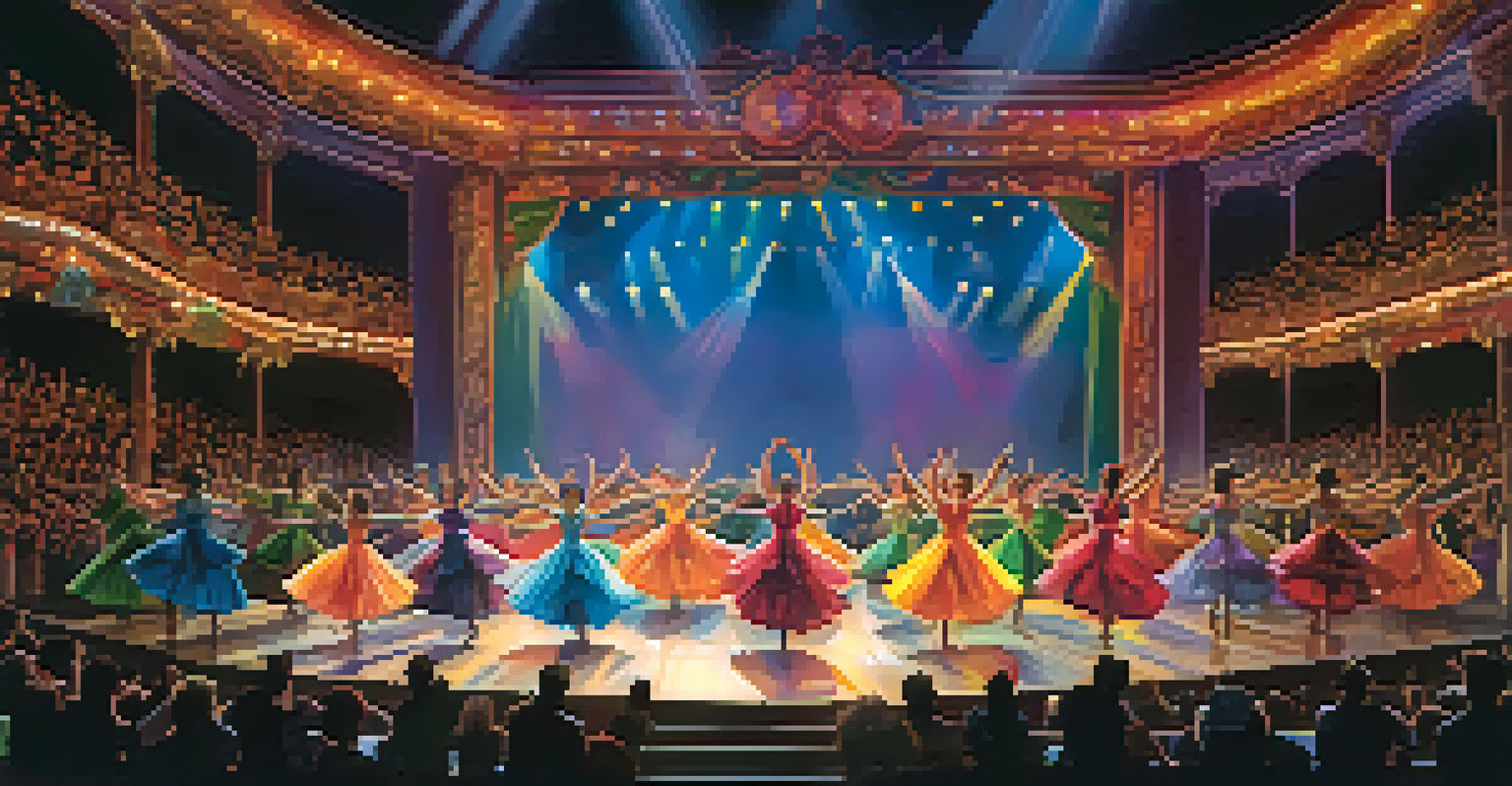Musical Films: The Symbiosis of Dance and Storytelling

Understanding Musical Films and Their Unique Appeal
Musical films are a captivating genre that combines storytelling with song and dance. They have a unique ability to engage audiences on multiple emotional levels, making them a beloved choice for many. Think of classics like 'The Sound of Music' or 'West Side Story,' where every note and dance step amplifies the narrative.
Music can change the world because it can change people.
These films draw viewers into a world where emotions are expressed not just through dialogue but through vibrant choreography and memorable melodies. This combination creates a rich tapestry of storytelling that resonates deeply. It's like watching a painting come to life, where every brushstroke tells part of the story.
Moreover, musical films often transcend cultural boundaries; their universal themes and catchy tunes appeal to a wide range of audiences. They remind us that music and dance are fundamental aspects of human experience, capable of conveying feelings that words alone sometimes cannot.
The Role of Dance in Enhancing Emotion and Narrative
Dance in musical films serves as a powerful tool for expressing emotions that might be difficult to articulate. It allows characters to showcase their feelings through movement, whether it's joy, sorrow, love, or conflict. For instance, the iconic dance sequences in 'La La Land' not only entertain but also deepen the viewer's understanding of the characters' emotional journeys.

The choreography often mirrors the story's themes, creating a visual representation of the narrative arc. This synergy between dance and storytelling adds layers of meaning that enrich the overall experience. Imagine the graceful movements in 'Singin' in the Rain'—each step is a reflection of the characters' struggles and triumphs.
The Emotional Power of Dance
Dance in musical films serves as a vital expression of complex emotions, allowing characters to convey feelings beyond words.
In essence, dance becomes a language of its own within these films, translating complex emotions into something universally understood. It invites the audience to connect more profoundly with the characters and their stories, ensuring that the emotional impact lingers long after the credits roll.
Iconic Musical Numbers That Defined the Genre
Certain musical numbers have become iconic, leaving a lasting imprint on the genre and pop culture. Songs like 'Do-Re-Mi' from 'The Sound of Music' or 'I Will Survive' from 'The Adventures of Priscilla, Queen of the Desert' blend catchy tunes with unforgettable choreography. These scenes often encapsulate the essence of the film, making them memorable moments that fans cherish.
Dance is the hidden language of the soul.
These musical numbers not only showcase the talents of the performers but also serve to advance the plot or develop characters. They are carefully crafted to fit seamlessly into the storyline, elevating the narrative while entertaining the audience. It's like a well-timed punchline that enhances a joke—it adds to the experience without feeling forced.
Moreover, the emotional connection fostered by these songs often leads to cultural phenomena, inspiring covers, dance challenges, and more. Their influence can be seen across generations, demonstrating the timeless nature of great musical filmmaking.
Choreography: The Heartbeat of Musical Films
Choreography is often considered the heartbeat of musical films, breathing life into the story through movement. Renowned choreographers like Bob Fosse and Jerome Robbins have shaped the genre with their distinctive styles, creating unforgettable dance sequences that audiences adore. Their work illustrates how dance can tell a story just as compellingly as dialogue.
The physicality of dance adds an extra layer of depth to the characters and their relationships. For example, in 'Chicago,' the choreography not only showcases the talent of the performers but also reflects the gritty world they inhabit. Each movement tells a story, revealing the characters' motivations and desires in a visual language.
Cultural Reflection and Impact
Musical films not only entertain but also reflect and shape societal values, addressing significant issues through their narratives.
Furthermore, choreography can influence the pacing and tone of a musical film, guiding the audience's emotions throughout the experience. It's like the rhythm of a heartbeat, setting the tempo for laughter, tension, and joy, ensuring that viewers remain engaged from start to finish.
The Evolution of Musical Films Through the Decades
Musical films have evolved significantly since their inception, adapting to cultural shifts and audience preferences. From the lavish productions of the Golden Age, like 'Singin' in the Rain,' to modern interpretations such as 'Mamma Mia!' and 'The Greatest Showman,' the genre continues to reinvent itself. Each decade brings fresh ideas, styles, and themes, reflecting the times in which they were created.
Today, musical films often blend genres, incorporating elements of drama, romance, and even fantasy. This versatility allows filmmakers to explore new storytelling avenues while keeping the musical format alive. It's fascinating to see how a traditional genre can evolve, much like how fashion trends come back with a modern twist.
As a result, new audiences are continually being introduced to the joy of musical storytelling. The evolution of this genre not only showcases its resilience but also emphasizes the timeless appeal of music and dance as forms of expression.
Cultural Impact of Musical Films on Society
Musical films have a profound cultural impact, often reflecting and shaping societal values and trends. They have the power to address important issues, such as love, acceptance, and perseverance, resonating with audiences on a personal level. For instance, 'Hairspray' tackled issues of racial equality and body positivity, using the medium of dance and song to convey a powerful message.
Moreover, these films can serve as a lens through which we view history and culture, providing insights into different eras and lifestyles. They encapsulate the spirit of their times, often influencing fashion, music, and even social movements. It's like a time capsule that captures the essence of a specific moment in history.
Evolving Musical Film Landscape
The genre continues to adapt to modern trends and technologies, ensuring its relevance and appeal to new audiences.
The communal experience of watching a musical film—whether in theaters or at home—also fosters a sense of connection among viewers. This shared enjoyment can lead to discussions, celebrations, and even movements, showcasing the ability of musical films to bring people together across diverse backgrounds.
The Future of Musical Films in Modern Cinema
As we look to the future, the landscape of musical films continues to evolve, embracing new technologies and storytelling techniques. Streaming platforms have opened up opportunities for diverse narratives and unique formats, allowing for a resurgence of interest in the genre. We’re seeing a rise in original musicals and adaptations that reflect contemporary issues and voices.
Incorporating elements like virtual reality or interactive experiences could redefine how audiences engage with musical films. Imagine being part of the performance, where viewers can influence the storyline or choreography—this could open up thrilling new avenues for storytelling. It's akin to how video games have transformed the way we experience narratives.

Ultimately, the future of musical films holds great promise, blending tradition with innovation. As filmmakers continue to experiment with the genre, we can expect to see fresh ideas that honor the past while paving the way for the next generation of musical storytelling.